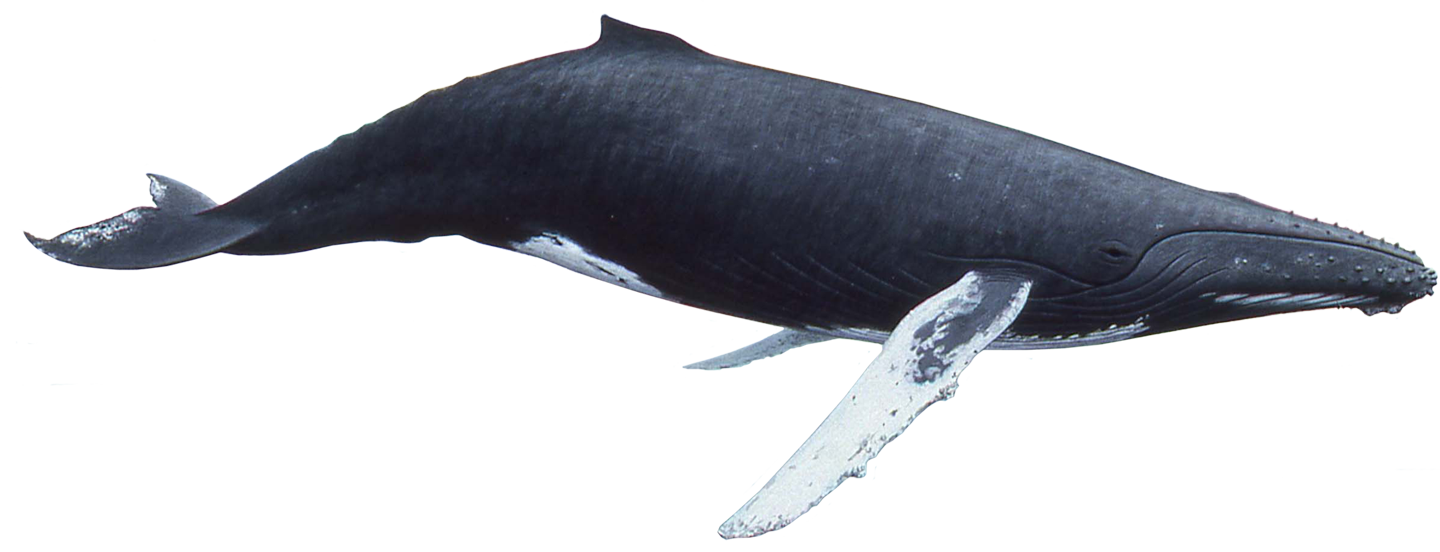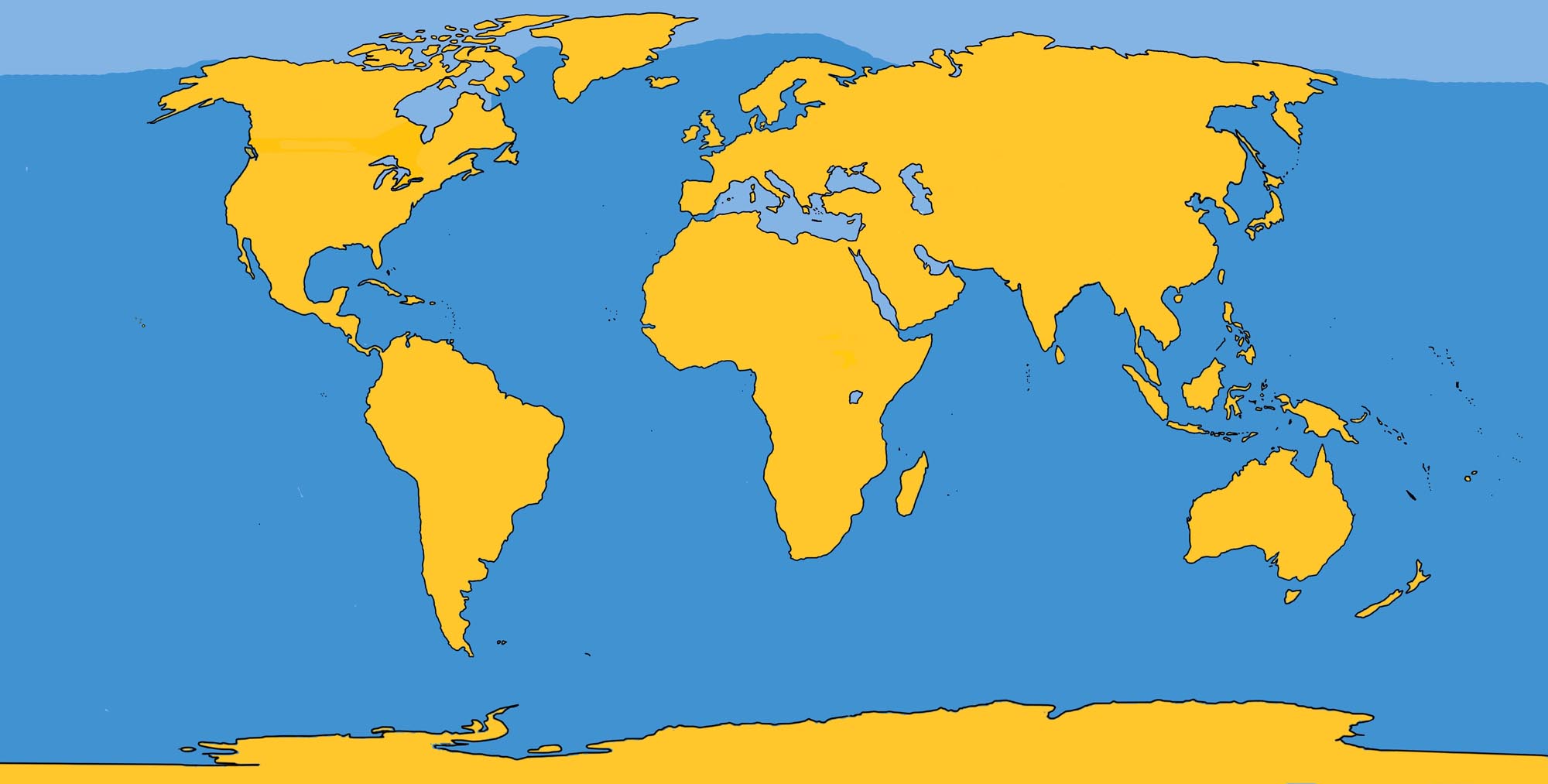 Family: Balaenopteridae
Family: Balaenopteridae
Genus: Megaptera
Species: M. novaeangliae (Borowski, 1781)
The only similarity between the humpback whale and other rorquals is the throat grooves, which extend from the chin to the navel. This whale is not long and sleek; its body is rounded, narrowing to a slender peduncle whose flukes, sharply serrated on the trailing edges, are unique among whales. The humpback’s facial characteristics are also unique because of the many knobs or protuberances containing hair follicles. Its flippers are one-third the length of the body; the longest among all cetaceans, and are knobby along the leading edge where finger bones end. The leading edges of the flippers are often covered with sharp barnacles. The flippers are highly flexible and mobile, and capable of dramatic gyrations when the animals breach.
The humpback is best known for its vocalizations, which cover many octaves and include frequencies beyond the threshold of human hearing. Humpback songs, apparently sung only by lone males, last as long as 20 minutes, after which they are repeated, often with slight changes. The songs occur only in those warm-water regions to which the animals migrate for breeding, and change from season to season, varying subtly among groups.
Experiences by divers have shown humpbacks to be both aware and cautious of the human visitors but without the slightest trace of hostility. The whales are careful to avoid collisions or other mishaps when divers approach.
Physical Description: The upper and lower edges of the mouth and the dorsal ridge from the blowhole to the tip of the jaw are covered with hair follicles set in conspicuous, rounded bumps. Charles Jurasz, noted humpback whale researcher, theorizes that only males possess knuckle-like bumps running along the dorsal ridge behind the dorsal fin.
Color: Humpbacks are black all over except for parts of the underside including the chin, throat, chest, belly and flukes. The white extends much further up along the sides in southern hemisphere populations. The flippers vary from all black to all white. The white on the underside of the flukes assist researchers in positive identification of individual animals, as the patterns exposed when the tail is lifted for a dive are unique to each whale. Often the entire body is covered with small scratches, presumably from physical contact with other barnacle-encrusted humpbacks.
Fins and Flukes: The dorsal fin is situated more than two-thirds of the way down the back, and varies in size and shape from one animal to another; it is usually small and may be barely discernible or large and falcate. The flippers are one-third the body length, extremely mobile and used for underwater maneuvering, among other things. The wide flukes are serrated and pointed at the tips. There is a definite median notch.
Length and Weight: Humpbacks reach 62 ft (19 m) in length and 53 tons (48,000 kg). Northern Hemisphere animals are slightly shorter than their Southern Hemisphere counterparts.
Throat Grooves: There are between 14 and 24 ventral grooves present, 5 to 8 in (13 to 20 cm) apart and extending slightly beyond the navel.
Baleen Plates: There are 350 to 370 baleen plates on each side of the upper jaw; blackish-brown in color. They reach 24 in (60 cm) in length.
Feeding: Humpbacks apparently only feed at the cold water end of their migration. Their diet includes krill, plankton, sardines, saury, mackerel, anchovy, capelin, and other small schooling fish. Humpbacks in Glacier Bay, Alaska, have been documented operating in organized groups, blowing underwater bubble circles to entrap plankton and small fish. They then swim up through the swarm, mouth agape, taking in large quantities of food.
Breathing and Diving: They remain on the surface for from 3to 6 minutes between long dives, breathing at 15- to 30-second intervals. A longer dive follows, marked often by the raising of the tail high into the air. Although this longer dive may last as long as 30 minutes, it is not necessarily a deep dive, as underwater observation confirms that the humpbacks dive vertically from the surface and often remain within several body lengths of it, twisting and rolling, often in close physical contact with one or more other animals. The humpback’s blow is tall, thin, and very obvious on a windless day.
Mating and Breeding: Calves are born 13 to 14 ft (4 to 4.3 m) in length after a gestation period believed to be 11.5 months. Mating and birthing takes place every second or third year, and calves may exceed 26 ft (8 m) when weaned seven months after birth. Sexual maturity is attained in males when they are 38 ft (11.5 m); females when they are 39 ft (12 m) long. Physical maturity is attained at 14 to 30 years when males are 43 ft (13 m) and females 45 ft (13.7 m).
Herding: They herd in groups of about a dozen on calving grounds, or in smaller groups of 3 to 4 separated by many miles during migration. It is not uncommon, however, to observe individuals and pairs on calving grounds. The newborn often stays in close proximity to the mother. When swimming, newborn have been observed to ride the mother’s slipstream as she swims. Adult and calf seem to be separated often from the main herd, accompanied by a second adult believed to be the father.
Distribution: They are found in all oceans to the edge of the ice but follow definite migratory routes. They occur in polar regions for half of the year and warmer waters during the remaining time.
There appear to be three geographically isolated populations —- North Pacific, North Atlantic, and Southern Hemisphere —- each comprised of several discrete stocks.
Migration: Some Southern Hemisphere stocks migrate during the winter from Antarctic waters to South African waters; some move up the coast of South America. Others travel north into the waters of New Zealand, Australia, the Fiji Islands, New Caledonia, and the New Hebrides. It is thought that some humpback populations from Greenland and the Barents Sea migrate south along the European coast into the upper North Atlantic waters, while others from the south of Greenland migrate through the western North Atlantic to Bermuda and the West indies. Populations from the Bering and Chuckchi seas migrate south along the North American coastline then west to Hawaii.
Natural History Notes: Humpbacks normally travel at between 2.5 to 6 mph (4 to 5 kph), but they can maintain speeds in excess of 12 mph (19 kph) for short periods of time. Belying their reputation as “gentle giants”, humpback males engage in severe fights in mating areas that often result in extensive scratching, scarring, and, on at least one occasion, bleeding. These fights determine which males will mate with and/or accompany females.
HUMPBACK WHALE DISTRIBUTION







